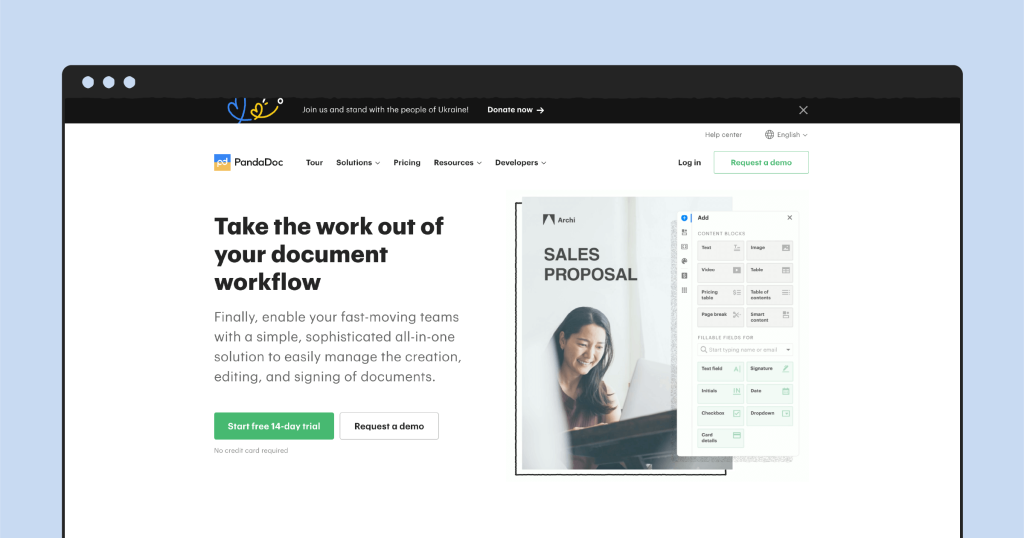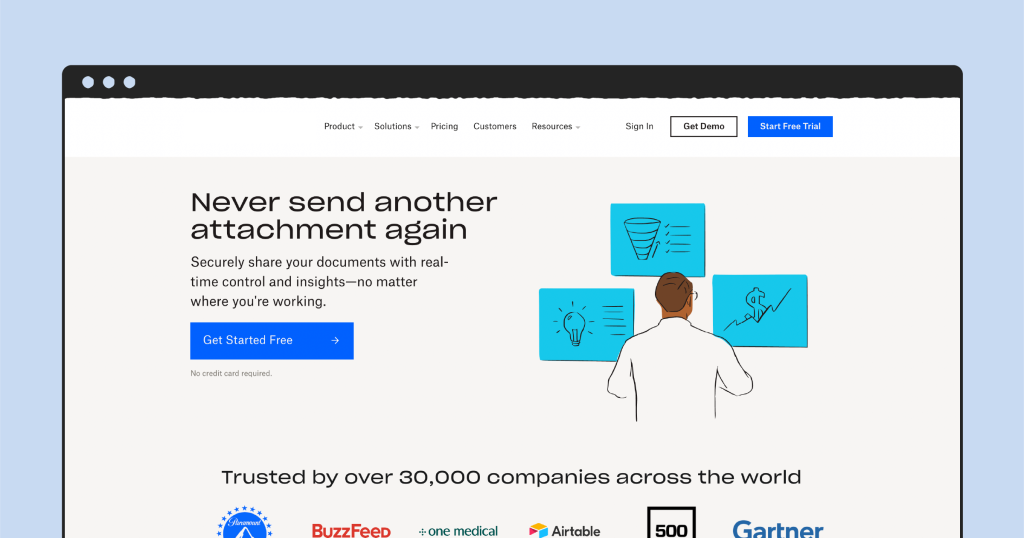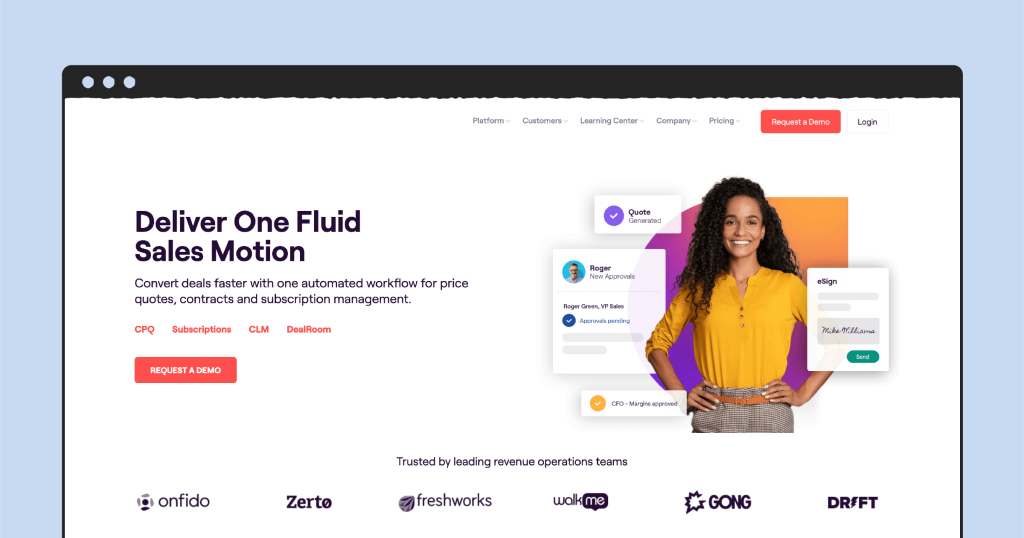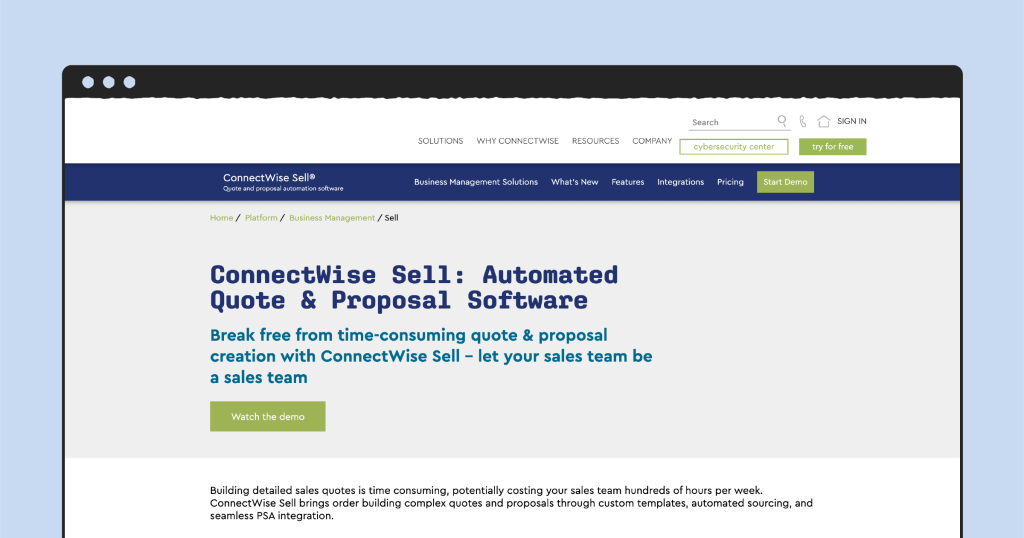Qwilr’s proposal management software is an interesting take on what many businesses view as a tedious and boring task.
The company takes a web-based approach to proposal creation and management by allowing users to build documents that resemble the look and feel of a website page.
Using Qwilr, you can add content blocks, pricing tables, video greetings, e-signature blocks, and more to close deals fast.
But this platform isn’t for everyone.
Sometimes you need software with more editing capabilities or better collaboration tools.
Today, we’re going to take a closer look at plans from 7 Qwilr alternatives so that you can see how they compare.
Let’s get to it.
12 best Qwilr alternatives in 2022
-
PandaDoc
-
Proposify
-
GetAccept
-
DocSend
-
BidSketch
-
Better Proposals
-
Proposable
-
DealHub
-
DocuSign
-
ClientPoint
-
QuoteWerks
-
ConnectWise Sell
How we sourced our data
To ensure maximum objectivity and a high level of information quality, we’ve scoured over 30 websites to collect unbiased data from different sources.
This includes renowned peer-review websites and publications as well as SaaS websites of each respective tool mentioned in this article.
Some relevant sources we used include:
It is also important to note that we only used the above-mentioned resources to seek factual information such as the features list, pricing, customer service, etc.
All other takeaways in this article are a result of endless product testing by our team of industry experts.
We also compared the plans on offer from every Qwilr alternative on our list and examined them closely for key differentiators and differences.
The information published below is a direct result of hours of research into what tools Qwilr and its competitors offer to help you build winning proposals.
01. PandaDoc

Plan name: Business
Cost: $49/month, paid annually
Ease of use: 4.6/5
Functionality: 4.8/5
Support options: Chat, email, product knowledge base
Free trial: 14 days. Free plan is also available
We might be slightly biased, but PandaDoc is a strong contender for anyone seeking an alternative to Qwilr.
Our software tools can help you close deals and increase productivity while managing teams and automating workflows.
PandaDoc is armed with a staggering number of integrations, most of which are available on the PandaDoc Business Plan.
This includes most CRM apps (HubSpot, Salesforce, etc.), along with integrations for Zapier, Slack, Stripe, and other tools in your tech stack.
Using PandaDoc as your all-in-one document platform, you can create documents completely from scratch, send them to the appropriate individual for e-signing, and then manage and store them throughout the entire contract management lifecycle.
And PandaDoc doesn’t stop with business proposals. You can create contracts, invoices, quotes, forms, and much more.
Our platform is equipped with a content library to help you automate content creation at a modular level.
You can also create your own templates or use any of the 750+ templates in our template library to streamline your sales operation.
How it’s different from Qwilr:
Without a doubt, PandaDoc is a powerful platform for document design and management — but how does it compare with Qwilr?
Overall, PandaDoc offers a more robust editor than Qwilr. Our document creation tools are more flexible and provide more control over the look and feel of your document.
Most of that comes down to the niche that Qwilr has carved out for itself. Qwilr is great if you’re looking to design proposals that have the look and feel of web pages.
And they do a great job of it. They offer custom branding and white labeling through custom subdomains that go far beyond what PandaDoc offers. (We don’t do anything with custom subdomains at all.)
Where Qwilr falls short comes down to a lack of versatility. The proposal pages they offer look like splashy and interesting web pages — because that’s exactly what they are!
It’s great for sales proposals, but those same tools can leave you in the lurch if you need to issue more traditional docs, like a sales contract or an invoice, without all of the bells and whistles.
Those perks, combined with our superior support and service options, are what give PandaDoc a major edge over Qwilr when it comes to CPQ operations.
But don’t take our word for it! Sign up for a free 14-day trial to see it for yourself
We promise that you won’t be disappointed.
02. Proposify

Plan name: Team
Cost: $49/user, billed quarterly or annually
Ease of use: 4.3/5
Functionality: 4.3/5
Support options: Chat support, knowledgebase
Free trial: 14 days
Another major competitor in proposal management software, Proposify comes equipped with a powerful document editor.
Similar to PandaDoc (mentioned above), you can build customized documents from scratch, including contracts, invoices, proposals, and more.
The app all comes with a fair number of integrations, although a few key integrations — like Salesforce — are only available on higher-tiered plans.
However, when it comes to creating stellar online proposals, Proposify is a top choice. The editor has a bit of a learning curve, but it’s easy to understand and feels great to use once you get the hang of it.
Plus, Proposify’s onboard automation tools make creating sales documents simple and easy.
How it’s different from Qwilr:
In the previous section, we mentioned how the PandaDoc editor gives you more flexibility to create documents that Qwilr isn’t well-equipped to handle (contracts, invoices, etc.).
By contrast, Proposify strikes a decent balance between PandaDoc and Qwilr. The editor you’ll find in Proposify isn’t quite as robust as what you’ll see in PandaDoc, but it gets the job done.
At the same time, Proposify does offer white labeling and custom domain integration for users who want to operate in the same way they would with Qwilr.
On the other hand, Qwilr offers greater flexibility around link sharing and control. You can still password protect documents, but the ability to filter office views or add page viewing limits aren’t feature sets that you’ll find in Proposify.
The Proposify interface is more traditional, as well. Qwilr’s pages look like full-blown web pages.
When you send a proposal via Proposify, the full editor will be visible so that stakeholders can interact with it more directly rather than simply scrolling down the page.
In some ways, these items are down to preference, but it’s impossible to ignore the added flexibility that you’ll get from using Proposify when compared to Qwilr.
03. GetAccept

Plan name: Professional
Cost: $49/user, billed annually
Ease of use: 4.3/5
Functionality: 4.4/5
Support options: Email, chat, phone, knowledge base
Free trial: 14-days. Free plan also available
GetAccept is a document management tool and a sales enablement platform all rolled into one.
This platform provides ways for your sales team to manage leads, deals, and documents with a battery of tools that go far beyond proposal creation.
The core of the GetAccept platform is the Deal Room, a digital salesroom where you can coordinate with a client to move deals forward.
The platform is equipped with several automation tools so that notifications and reminders are sent automatically.
As with most of the other Qwilr competitors on our list, GetAccept allows users to e-sign documents and collaborate to push deals past the finish line.
You’ll even get access to document analytics for a closer look at how your deals are progressing and where things might be stalled.
How it’s different from Qwilr:
Qwilr will help you design great sales proposals from scratch or by using predesigned proposal templates and customizing them.
GetAccept offers some limited functionality in this regard. But, while the onboard proposal builder is actively being developed, it’s not as powerful as what you’ll experience with Qwilr.
As a tradeoff, GetAccpet provides better insights into your leads. The platform offers considerable tracking tools for documents.
Sales dashboards make it easy to manage your content, and deals scoring can help you figure out where to focus your effort for the best results.
You can even collaborate with clients directly through live chat systems to make your sales process more personable and approachable while documents are up for review.
Oddly, GetAccept doesn’t offer a payment gateway. In our view, this is a major downside compared with Qwilr and other competitors on our list, since it forces you to take care of credit card transactions and payment transfers via a separate platform.
However, if you’re looking for a system that provides adequate proposal creation and extra emphasis on deal management, GetAccept is worth a look.
04. DocSend

Plan name: Standard
Cost: $45/user, billed annually
Ease of use: 4.5/5
Functionality: 4.3/5
Support options: Chat, email, phone, knowledge base
Free trial: 14 days
DocSend might easily be considered the strangest addition to our list until you consider it on the merits.
Unlike the other proposal management solutions we’ve covered, DocSend is more of a document management system.
While it does provide Deal Rooms like GetAccept, DocSend doesn’t provide proposal creation software tools like PandaDoc or Proposify.
Instead, DocSend helps you manage and control all of your documents in a way that is vastly superior to any other platform on our list.
DocSend provides tools that are designed to help you safely share and maintain control of all documents, all the time.
The platform offers advanced tools, like document watermarking and one-click NDAs (advanced/enterprise plans only), so that you can protect valuable documents and relevant information easily.
As with other proposal documents on our list, you can still use the platform for e-signing and real-time collaboration.
You’ll have access to a branded document viewer and custom subdomain, as well as advanced administrative tools to restrict document access and permissions.
It’s a useful tool when you need to share a collection of documents or start a conversation that goes beyond a single proposal.
How it’s different from Qwilr:
If you’re comparing proposal management solutions on a one-for-one basis, DocSend will seem like a strange contender when compared to Qwilr.
In some ways, that’s true. Qwilr won’t help you build a sales proposal at all. You’ll need to create that using a different tool, like Microsoft Word or Adobe InDesign.
You could also use online tools like PandaDoc or Proposify, but you’re likely to find too much overlap between DocSend and others to justify the expense.
Once you have all your documents ready to go, you can upload them to your DocSend workspace and send them to leads and clients for review.
This is where DocSend truly shines.
As with Qwilr, you can easily control permissions and access. You can create a branded document viewer or a branded subdomain to customize the user experience.
But DocSend takes things to the next level with sharing and permission controls that are far beyond what Qwilr can offer.
That’s why, when comparing these tools, you’ll need to consider what is more valuable overall.
DocSend won’t help you create stellar business proposals, but it can help you manage your proposals and other documents in a better way.
05. BidSketch

Plan name: Team
Cost: $47/month, billed annually
Ease of use: 4.3/5
Functionality: 4.1/5
Support options: Email, knowledge base
Free trial: 14 days
Compared to other platforms on our list, Bidsketch takes a different approach to proposal construction.
This platform might best be called a “proposal builder” rather than a from-scratch proposal creation tool like what you’d see with Qwilr, PandaDoc, or Proposify.
With Bidsketch, you’ll input all of the appropriate information into the backend of your proposal. When you’re done, Bidsketch will “build” the proposal for you by formatting everything and adding a nice cover image.
While this approach limits the control that you’ll have over the finished product, it does have the advantage of keeping the focus squarely on the proposal content when you’re writing everything.
This can also limit the product in some ways if you’re trying to design additional sales collateral, like contracts and invoices.
You’ll still have access to proposal analytics, as well as the ability to conduct e-signing, although payment collection isn’t available and you won’t find much in the way of third-party integrations.
How it’s different from Qwilr:
Because of how Bidsketch builds its documents, the entire interaction is far different from what you’ll experience with Qwilr.
You’ll still get a proposal at the end, and you can still create a custom domain for hosting, but the look and feel of the end product will be entirely different.
Bidsketch won’t offer much by way of restricted sharing and document control, but you can white label the content, create templates, and review document analytics.
Overall, choosing Bidsketch will come down to what kind of document you’d prefer to create. The look and feel of the Bidsketch output is far more traditional than what Qwilr brings to the table.
Considering the lack of form creation, payment gateways, and a lack of sales enablement features, you should be prepared to look for other solutions in order to complete your deals process.
06. Better Proposals

Plan name: Premium
Cost: $21/user, billed annually
Ease of use: 4.4/5
Functionality: 4.2/5
Support options: Chat, knowledgebase, training (online)
Free trial: 14 days
Better Proposals offers an online builder designed to help you create a professional impression at first glance with almost any form of sales collateral.
It’s also one of the most cost-effective options on our list, so it’s worth a look if you’re aiming for a great balance between features and cost.
Like most of the other builders we’ve covered, Better Proposals guides you through document creation using a block system.
You’ll start with your title or cover page, then add text blocks, images, and pricing tables to create a full-length document or proposal.
The tool also comes with hundreds of free templates for everything from RPF requests to brochures and info sheets that you can use on social media.
Live chat and messaging are also integrated into the proposal tool, which is great for real-time collaboration.
How it’s different from Qwilr:
Better Proposals is closely related to Qwilr in terms of product offering and final output. The end result isn’t as flashy, but it functions in much the same way.
However, Better Proposals offers some interesting tools that are worth considering.
The analytics on the platform are more granular than what you’ll see with Qwilr, so you’ll have better insights into how individuals interacted with your documents over time.
Better Proposals also offers a tool called Proposal AI, which finds weaknesses in your document and makes suggestions on how to improve them.
While some of these suggestions are useful, it’s not a total game-changer if you have good design sense and a few good examples of how proposals should be designed.
Better Proposals also come with one drawback. On the Premium Plan, you’re limited to sending 50 proposals per month.
You can switch to a higher-tier plan for unlimited proposal generation for around $49/user per month. It’s a minor upcharge, but one to be aware of if you’re sending a large number of proposals.
07. Proposable

Plan name: Premium
Cost: $39/month, billed monthly
Ease of use: 4.2/5
Functionality: 4/5
Support options: Email, chat, knowledge base
Free trial: 14 days
Proposable offers an onboard proposal builder and collaboration tools to help you keep momentum behind every deal that you want to close.
Using the builder, you’ll add the appropriate content blocks to your document, including payment and e-signing blocks to secure payments and legally binding approvals.
The platform also has quotes and estimates covered. Using the flexible estimates block, you’ll be able to build pricing tables on a per-line basis.
You’ll also find a pricing catalog enabled for fast and easy product recall for key items.
Overall, Proposable is a respectable document generation tool. While it lacks some of the more powerful features for advanced editors like PandaDoc and Qwilr, it’s a great option when you want to build a solid-looking sales doc.
How it’s different from Qwilr:
With Qwilr, you’re designing online with modern web design elements in mind. Proposable diverts from that path entirely.
Though the proposal is created and hosted online (hosting through customer subdomains is possible), the look and feel that you’ll see from the final output is entirely different.
As with most of the other proposal tools on our list, customers will end up in a public-facing version of a document editor in order to review and sign off when dealing with files.
You’ll have access to internal commenting tools and more than enough power to get work done. But even knowing all of that, the platform feels simple and easy to work with.
Analytics are somewhat limited, especially at the Team level. It’s possible to gain additional information and insights by upgrading to the Enterprise plan, but it’s a considerable jump in price ($500+/month) to do so.
08. DealHub

Plan name: DealRoom
Cost: Available by request
Ease of use: 4.7/5
Functionality: 4.3/5
Support options: Email, phone, knowledge base, account manager
Free trial: No
DealHub is an all-in-one sales platform designed to make quoting faster and easier. The platform uses a combination of template tools and data importing to make quote and proposal generation fast and easy.
But DealHub goes beyond basic document preparation by incorporating features like playbooks for guided selling and deal rooms where sales reps and clients can meet to hammer out details and move deals along.
At higher tiers, DealHub is also heavily focused on subscription management and includes several features around long-term plan management, including multi-year subscription arrangements, bundle packaging, and more.
As a document generation tool, DealHub aims to create quotes and sales documents that are customized to user needs with as few clicks as possible.
To do this, the company provides pre-built templates — as well as the ability to create custom templates — for your sales processes.
From there, you can simply plug in your CRM data to the template and generate a sales quote in moments.
With the guided selling features, you can even create question-based workflows that will guide reps through the CPQ process.
As reps fill out the questions, the recommended quote and all additional features and upgrades will be compiled and customized directly to customer needs.
If you’re looking for a leg up on sales management and performance, this is a great feature to have.
How it’s different from Qwilr:
The biggest difference between DealHub and Qwilr comes down to what each platform is trying to achieve.
While Qwilr wants to create stunning sales docs that present themselves as web pages, DealHub is more interested in sales enablement and guided selling for your team.
DealHub’s quotes won’t be as flashy as what you’d see with Qwilr, but they look good and are more than enough to get the job done.
If you’re a smaller business, DealHub may not make sense due to the scope of the product. This platform is geared more towards established teams who need to send out customizable price quotes in short order.
Smaller teams who can get by with one or two proposal templates and/or lack major complexity when it comes to quote customization will probably find DealHub to be far more than they need to get the job done.
At higher tiers, DealHub adds subscription management to its lineup.
This is clearly targeted toward tech organizations offering subscription-based services, so it might be a bit niche if you’re outside of that platform. However, if it’s the right fit, there isn’t anything else quite like it on the market.
09. DocuSign

Plan name: Standard
Cost: $25/month, billed annually
Ease of use: 4.5/5
Functionality: 4.1/5
Support options: Email, knowledge base
Free trial: 30 days
No comparison article would be complete without DocuSign. It’s the quintessential e-signing platform, and it’s still a major player when you want to get documents signed in a fast and easy way.
Of course, it’s not the only player in the market. Most document generation platforms, including Qwilr (and PandaDoc) over electronic signature solutions as part of the document generation process.
For better or worse, this remains at the core of DocuSign’s primary focus.
However, this comes with some drawbacks. DocuSign handles e-signing, but not document creation or generation.
All of that will need to be handled elsewhere, typically through Google Docs, Microsoft Word, or some other docuemnt generation or word processing tool.
If you’re looking for a more holistic solution for your document process, DocuSign may not be the answer for you.
How it’s different from Qwilr:
Electronic signature capture is something that both Qwilr and DocuSign have in common. Both can help you capture legally binding signatures for documents sent to prospects and customers.
Qwilr’s main advantage is that it can help you design your documents from scratch. This is something that DocuSign simply doesn’t do, and that lack of functionaltiy makes this something of a one-sided comparison.
Qwilr’s document design tools are simple to use, and they’re sure to catch the eye. With DocuSign, you’ll be relying on an in-house design team to create PDF documentation, which can elongate the quoting process and slow down deal progression.
On the other hand, DocuSign is a more flexible solution because it can be used to capture electronic signatures for anything from flashy sales quotes to cut-and-dried contract renewals.
While DocuSign’s editing and formatting tools are very simple, they’re more than enough to get the job done when you have a preset or preloaded template.
In many ways, choosing between these two tools will come down to your business needs. If you already have all of your quoting designs handled, DocuSign might be a great fit.
If you want to design fresh quotes and ensure a great browign experience every time, Qwilr could be the better solution due to the features on offer.
10. ClientPoint

Plan name: N/A
Cost: $95/month, billed monthly; additionally user pricing varies
Ease of use: 4.4/5
Functionality: 4.1/5
Support options: Email, Knowledge base
Free trial: Not available
Designed as a cross between an administrative business platform and a document generation tool, ClientPoint aims to improve the client relationship by centeralizing all aspects of a project under one roof.
With ClientPoint, you can manage projects, generate documents and reports, manage content, schedule meetings, and more.
The main idea with this software is to consolidate your tech stack into a single tool through integrations and connections so that your sales and project teams are all working with the same, consistent interface.
Keep in mind that ClientPoint isn’t trying to act as a replacement for many of your standard software tools.
For example, you could schedule a meeting through ClientPoint using Zoom or RingCentral, but this platform wouldn’t replace the apps and software tools you already use.
For companies looking toward solutions that manage client relationships, ClientPoint provides strong workflows to help you close deals and keep customers happy.
How it’s different from Qwilr:
As with many other Qwilr alternatives on our list, ClientPoint offers a much broader range of features when compared to Qwilr, especially around relationship management and CLM.
There is some overlap, however. Both tools provide document generation as a cornerstone of their product offering.
With Qwilr, making web-based, digital sales proposals is the entire reason to use the platform.
ClientPoint also offers document generation. This is based around creating a content library and then using the elements you need to create proposals and other documentation on the fly.
Both tools offer a drag and drop interface, but Qwilr’s design tool is more robust and more web friendly.
ClientPoint offers a branded online viewer, so you still have control over the user experience, but the final output can’t compare to the quality of documentation that Qwilr can produce.
It’s also important to note that ClientPoint is no slouch when it comes to analytics, tracking, and document management.
With Qwilr, some of these aspects would need to be handled by another software tool. ClientPoint tries to handle all of that tedium while helping you create documents at the same time.
If you already have a system that you enjoy when it comes to project management, ClientPoint probably won’t make sense. Overall, Qwilr’s web-based design tools give you greater flexibility.
On the other hand, Qwilr’s output still needs to be managed by another tool — typically a CRM.
If you want to consolidate the management aspect of document generation into a more structured workflow, ClientPoint is worth a look.
11. QuoteWerks

Plan name: Corporate
Cost: $99/month, billed monthly
Ease of use: 4.2/5
Functionality: 4/5
Support options: Email, phone, knowledge base
Free trial: Available upon request
One of the last desktop-deployable quoting tools on the market, QuoteWerks is designed for sales quoting at scale.
The system takes most of the guesswork out of proposal design and relies on a robust product library to streamline the quoting process.
Using QuoteWerks, reps will plug all relevant product information and details into the builder, click a button, and wait for the software tool to generate a properly formatted proposal.
No design work or customized formatting is involved.
While approach that QuoteWerks uses makes it easier than ever to generate quotes quickly and with minimal room for error, there are some drawbacks.
The pricing, while compartmentalized, can be confusing and the ability to do many of the things that are built into other quoting services (like sending quotes online) require add-ons and upgrades to the basic plan.
How it’s different from Qwilr:
QuoteWerks takes a more nuts-and-bolts approach to quoting and proposals. This software is very much geared toward companies with larger product libraries who want to send quotes consistently and quickly.
This is the main differentiator between QuoteWerks and Qwilr. With Qwilr, you have the design flexibility to make great-looking sales docs that are optimized for web performance.
With QuoteWerks, design takes a backseat to practical flexibility.
While the look and feel of the final quote will be sufficient to carry the information, the app doesn’t provide much in the way of minor adjustments or on-the-fly customization. It’s strictly input/output.
Qwiler’s pricing setup is also much more straightforward compared to what you see with QuoteWerks. Qwilr offers two pricing plans.
QuoteWerks offers three, plus additional add-ons like QuoteValet for electronic quote delivery (versus only sending via email), database hosting, web subscriptions, and more.
If you’re looking for a quoting tool where design is secondary to performance, it’s possible that QuoteWerks is a good fit, but it may take some effort to figure out exactly what you need and how best to implement that solution for your business.
12. ConnectWise Sell

Plan name: Standard
Cost: Available upon request
Ease of use: 3.9/5
Functionality: 3.5/5
Support options: Email, chat, phone, knowledge base
Free trial: Not available
ConnectWise Sell is just one of many software tools that comprise the ConnectWise family of products. The platform also offers solutions for cybersecurity, policy management, staffing and back-of-house management, and much more.
Why does that matter? Because ConnectWise offers such a broad array of solutions that you might find it difficult to only use one of the solutions that they offer.
The tools work better together, and each ConnectWise product you subscribe to will allow the platform to help you manage more of your business
Especially for ConnectWise Sell, you’ll be able to generate quotes and manage your sales team all through a single platform.
However, many of the most powerful and effective features, like payment collection an guided selling, are only available at the premium level.
How it’s different from Qwilr:
At the end of the day, Qwilr’s sphere of influence in your sales process is limited to the documents you create.
And don’t get us wrong: Qwilr offers a huge amount of functionality around the quote design and development process.
ConnectWise Sell is aimed at teams who need to simplify complex quoting process and automate time-consuming processes like procurement and sourcing.
The platform’s quotes look professional, and ConnectWise offers many of the same user tools that you’d see with Qwilr, like notifications and reporting, but the output and the aim are both different.
As with so many of the sales management and sales enablement platforms that we’ve covered, ConnectWise Sell is designed to help you fill one aspect of your sales apparatus before moving you to another ConnectWise software solution somewhere farther down the pipeline.
If you’re not looking to scale up dramatically, ConnectWise probably isn’t the best way forward.
However, for teams who need it, ConnectWise Sell can be the first step into a suite of powerful business apps that can transform your business operations.
So what’s the best Qwilr alternative?
When it comes to proposal creation and management, the competition is obviously stiff.
Companies are always looking to improve and optimize their tools to meet the needs of all their clients, which makes the selection process that much more difficult.
While you should always go for the tool that suits the needs of your business, we believe that you won’t find a more comprehensive and user-friendly solution than PandaDoc.
Our team has invested endless hours in research and product optimization to create an intuitive document creation platform suitable for users and businesses of all sizes.
PandaDoc offers a plethora of integrations to simplify the workflow, allowing you to create winning documents quickly and effortlessly.
Our free package is more than enough to handle basic activities like payments and legally binding electronic signatures. We also offer a more comprehensive set of features through more advanced plans.
Start your 14-day free trial now and learn why PandaDoc is a favorite in the document management industry.
Looking For Document Management System?
Call Pursho @ 0731-6725516
Check PURSHO WRYTES Automatic Content Generator
https://wrytes.purshology.com/home
Telegram Group One Must Follow :
For Startups: https://t.me/daily_business_reads





